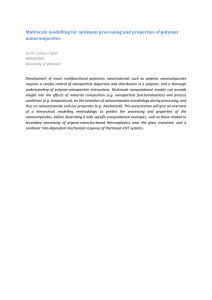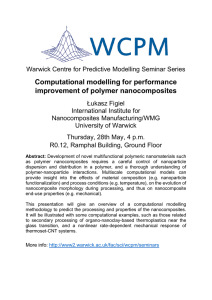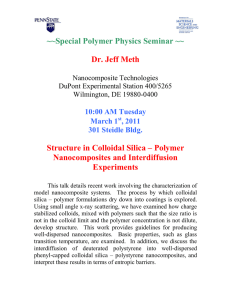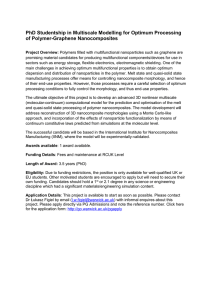“Green” Nanocomposites for Electronic Packaging
advertisement
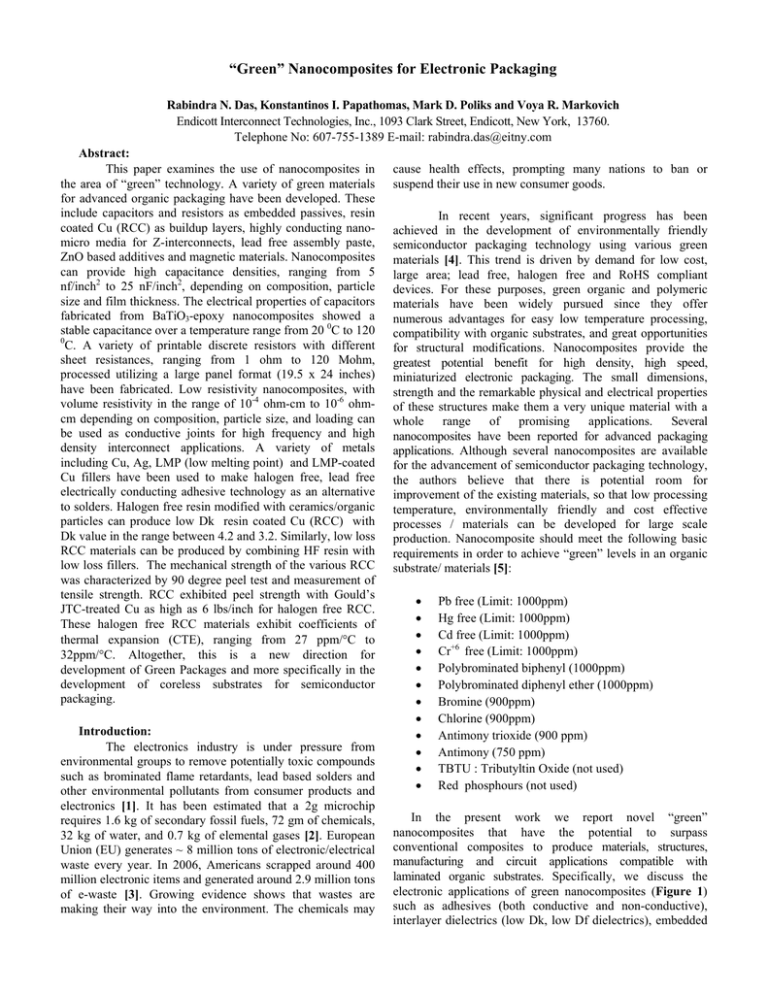
“Green” Nanocomposites for Electronic Packaging Rabindra N. Das, Konstantinos I. Papathomas, Mark D. Poliks and Voya R. Markovich Endicott Interconnect Technologies, Inc., 1093 Clark Street, Endicott, New York, 13760. Telephone No: 607-755-1389 E-mail: rabindra.das@eitny.com Abstract: This paper examines the use of nanocomposites in the area of “green” technology. A variety of green materials for advanced organic packaging have been developed. These include capacitors and resistors as embedded passives, resin coated Cu (RCC) as buildup layers, highly conducting nanomicro media for Z-interconnects, lead free assembly paste, ZnO based additives and magnetic materials. Nanocomposites can provide high capacitance densities, ranging from 5 nf/inch2 to 25 nF/inch2, depending on composition, particle size and film thickness. The electrical properties of capacitors fabricated from BaTiO3-epoxy nanocomposites showed a stable capacitance over a temperature range from 20 0C to 120 0 C. A variety of printable discrete resistors with different sheet resistances, ranging from 1 ohm to 120 Mohm, processed utilizing a large panel format (19.5 x 24 inches) have been fabricated. Low resistivity nanocomposites, with volume resistivity in the range of 10-4 ohm-cm to 10-6 ohmcm depending on composition, particle size, and loading can be used as conductive joints for high frequency and high density interconnect applications. A variety of metals including Cu, Ag, LMP (low melting point) and LMP-coated Cu fillers have been used to make halogen free, lead free electrically conducting adhesive technology as an alternative to solders. Halogen free resin modified with ceramics/organic particles can produce low Dk resin coated Cu (RCC) with Dk value in the range between 4.2 and 3.2. Similarly, low loss RCC materials can be produced by combining HF resin with low loss fillers. The mechanical strength of the various RCC was characterized by 90 degree peel test and measurement of tensile strength. RCC exhibited peel strength with Gould’s JTC-treated Cu as high as 6 lbs/inch for halogen free RCC. These halogen free RCC materials exhibit coefficients of thermal expansion (CTE), ranging from 27 ppm/°C to 32ppm/°C. Altogether, this is a new direction for development of Green Packages and more specifically in the development of coreless substrates for semiconductor packaging. Introduction: The electronics industry is under pressure from environmental groups to remove potentially toxic compounds such as brominated flame retardants, lead based solders and other environmental pollutants from consumer products and electronics [1]. It has been estimated that a 2g microchip requires 1.6 kg of secondary fossil fuels, 72 gm of chemicals, 32 kg of water, and 0.7 kg of elemental gases [2]. European Union (EU) generates ~ 8 million tons of electronic/electrical waste every year. In 2006, Americans scrapped around 400 million electronic items and generated around 2.9 million tons of e-waste [3]. Growing evidence shows that wastes are making their way into the environment. The chemicals may cause health effects, prompting many nations to ban or suspend their use in new consumer goods. In recent years, significant progress has been achieved in the development of environmentally friendly semiconductor packaging technology using various green materials [4]. This trend is driven by demand for low cost, large area; lead free, halogen free and RoHS compliant devices. For these purposes, green organic and polymeric materials have been widely pursued since they offer numerous advantages for easy low temperature processing, compatibility with organic substrates, and great opportunities for structural modifications. Nanocomposites provide the greatest potential benefit for high density, high speed, miniaturized electronic packaging. The small dimensions, strength and the remarkable physical and electrical properties of these structures make them a very unique material with a whole range of promising applications. Several nanocomposites have been reported for advanced packaging applications. Although several nanocomposites are available for the advancement of semiconductor packaging technology, the authors believe that there is potential room for improvement of the existing materials, so that low processing temperature, environmentally friendly and cost effective processes / materials can be developed for large scale production. Nanocomposite should meet the following basic requirements in order to achieve “green” levels in an organic substrate/ materials [5]: • • • • • • • • • • • • Pb free (Limit: 1000ppm) Hg free (Limit: 1000ppm) Cd free (Limit: 1000ppm) Cr+6 free (Limit: 1000ppm) Polybrominated biphenyl (1000ppm) Polybrominated diphenyl ether (1000ppm) Bromine (900ppm) Chlorine (900ppm) Antimony trioxide (900 ppm) Antimony (750 ppm) TBTU : Tributyltin Oxide (not used) Red phosphours (not used) In the present work we report novel “green” nanocomposites that have the potential to surpass conventional composites to produce materials, structures, manufacturing and circuit applications compatible with laminated organic substrates. Specifically, we discuss the electronic applications of green nanocomposites (Figure 1) such as adhesives (both conductive and non-conductive), interlayer dielectrics (low Dk, low Df dielectrics), embedded passives (capacitors, resistors), circuits, etc. The use of halogen free (HF) epoxy and other chemistry based resins as the typical polymer matrix and a range of metal /ceramic fillers with particle size ranging from 10 nm to 10 microns is reported. The addition of different fillers into the polymer matrix controls the overall electrical properties of the composites. For example, adding zinc oxide nano particles into a polymer show laser like behavior upon optical pumping and addition of barium titanate (BaTiO3) nanoparticles result in high capacitance. Halogen free materials have advantages in terms of manufacturability, processing temperatures, low moisture absorption, high glass transition temperatures, and versatility making it quite promising for advanced packaging. However, homogeneous dispersions of ceramic particles in the polymer matrix is a critical step in order to obtain films having uniform properties. Figure 1: Overview of some of the potential applications of “green” nanocomposites in microelectronics. 2. Experimental Procedure A variety of BaTiO3, ZnO (zinc oxide), silver nano particles and their dispersion into halogen free polymer were investigated in order to achieve uniform prints and coatings. In a typical procedure, ZnO/Ag/BaTiO3 halogen free polymer nanocomposites were prepared by mixing appropriate amounts of the nano powders and polymers in organic solvents. A thin film of this nanocomposite was then printed/coated on a copper substrate and cured. The content of metal/ceramic filler in the composites ranged from 40% to 95% by weight, depending on application. In the case of laminates, two thin films were prepared, dried, and then laminated together. Electrical properties (capacitance, Dk, Df) of the nanocomposite thin films were measured at room temperature using an impedance/gain-phase analyzer (Model 4194A, HEWLETT-PACKARD). Surface morphology and particle distributions of nanocomposite films were characterized by a LEO 1550 scanning electron microscope (SEM). Resistance of materials was determined by Keithley micro-ohmmeter. Heat of reaction of HF materials was studied using a differential scanning calorimeter (DSC). Practical adhesion (90 degree peel test) and tensile strength were measured using an Instron (Model 1122) and MTS tensile tester, respectively. 3. Results and Discussion In electronic applications, the HF materials are generally required to possess a wide range of favorable properties including high mechanical strength, good thermal stability and chemical resistance, low heat distortion, high resistance to aging, good electric insulation properties, consistent dimensional stability over a wide temperature range, good adhesion to glass and copper, high surface resistivity, low dielectric constant and loss factor, ease of drillability, low water absorption and high corrosion resistance. In addition, a key requirement that is governed by Underwriters' Laboratory (UL) is the ability to meet the flammability standard of UL 94-V0. In general thermosetting resins alone or in combinations with other additives, which are widely used in the electronic industry for PCB laminate applications, meet these requirements only because they contain approximately 20-40% brominated components. These brominated compounds have excellent flame-retardant properties. In the thermal processes, brominated compound can release corrosive byproducts such as HBr, Br2 etc. The greatest concern of brominated compound is the risk of forming potential dioxins (extreme health hazards) by uncontrolled pyrolysis. We have developed halogen free laminating resins for substrate material. Halogen free resins have advantages for multilayer substrates in terms of processibility, thermal stability, low moisture absorption, high Tg, and versatility. However, processing and composition of HF materials is critical in order to achieve high quality, reliable package. Figure 2 shows typical examples of halogen free 2-4-2 package cross section where 4 layer internal core and subsequent 2 buildup layers (each side) used to form 2-42 structure. Halogen free resin coated copper (RCC) materials can be used to form buildup layers. The 4 layer internal core can have two resistance layers in the middle and the two capacitance layer sequentially applied on the surface. This allows multiple capacitance/resistance layers in a thin total structure. This paper examines the use of various halogen free polymer-ceramic nanocomposites in the area of substrates and assembly technology. Nevertheless, nanocomposites with desired properties, thickness, and tolerance present significant challenges. Figure 2: Halogen free substrate cross-section showing core and build-up layers. RCC (A) Capacitor Laminate RCC RC3 : Resin coated copper capacitive Thin Core (B) RC3 : Resin coated copper capacitive (C) Figure 3: Photographs of (BaTiO3)-HF polymer nanocomposite films (A) Substrate build with capacitor laminates, (B) Substrate build with RC3 materials, and (C) representative cross section view of embedded capacitors using halogen free printable nanocomposites. nanocomposites capable of providing bulk decoupling capacitance for a conventional power-power core, or for a Capacitors and resistors: Embedded capacitors provide the greatest potential three layer Voltage-Ground-Voltage type power core, is benefit for high density, high speed and low voltage IC described. The second capacitor in this case study was packaging. Capacitors can be embedded into the interconnect discrete capacitor. This capacitor is constructed using substrate (printed wiring board, flex, MCM-L, interposer) to screen/stencil process. In the case of laminates, two thin films provide decoupling, bypass, termination, and frequency were prepared, dried and then laminated together. Figure 3 determining functions[6]. In order for embedded capacitors to shows series of thin film and printed capacitors. RC3 with be useful, the capacitive densities must be high enough to make suitable thickness favors buildup layers for sequential buildup layout areas reasonable. In this paper, we report novel BaTiO3- process as can be seen in Figure 3(B). On the other hand, HF Epoxy based polymer nanocomposites that have the laminates with proper processing can be used as central core potential to surpass conventional composite to produce high for buildups. Figure 3(C) represents screen printed embedded capacitance density, low loss, and applicable over large capacitors. It is interesting to note that present process can surface areas, thin film capacitors. Specifically, novel halogen manufacture large size (19.5 inch X 24 inch) halogen free free and lead free Resin Coated Copper Capacitive (RC3) RC3, laminates and printable capacitors. The electrical properties of ~2-100 mm2 capacitors fabricated from nanocomposite thin films showed high capacitance density ranging from 5 nF/inch2 to 25 nF/inch2, depending on composition, particle size and thickness of the coatings. Thin film capacitors fabricated from 40-60% v/v BaTiO3 epoxy nanocomposites showed a capacitance density in the range of 5-20 nF/inch2 that was stable over a frequency range of 1MHz to 10 MHz. Electrical properties of capacitors fabricated from ~70% v/v nanocomposite showed capacitance density of about 25 nF/inch2. For a given composition, capacitance density and dielectric loss increase with decreasing thickness. Figure 4A shows the room temperature capacitance profile measured at 1.0 MHz - 5 MHz for a BaTiO3-epoxy nanocomposite thin film as a typical representative example. It was found that with increasing frequency, the capacitance density decreased. Change in capacitance with frequency was less pronounced in the case of thicker films. 0.12 Thin-Cp Thick-Cp Thin-Loss Thick-Loss 15 10 0.06 5 0.03 5 4 3 2 1 0 0 50 100 150 Temperature (0C) Figure 4B: Change in capacitance with temperature for ~ 100 mm2 embedded capacitors Most of the nanocomposites tested, 15μm through 35 μm thick, for which the BaTiO3-based ceramic filler concentration was less than 50 vol%, passed 300 volt test. The outcome of high voltage testing depends upon the microstructure and thickness of the film. Nanocomposite film 15 to 25 microns thick and consisting of 1micron and 65 nm particles passed 300 volts, whereas 35 μm thick films passed 500 volt test. This is high enough for the nanocomposite to serve as an insulating material for embedded capacitors. Representative examples of temperature profiles (20°C 120°C) of thin film embedded capacitors are shown in Figure 4B. We have used around 15 individual capacitors for high temperature testing. The electrical properties of capacitors fabricated from halogen free nanocomposites showed a stable capacitance over a temperature range of 20°C to 120°C. Substrate with metal pad 0.09 Loss Capacitance (nF/inch2) 20 film.) Capacitance (nF) In the nanocomposite, BaTiO3 nano particles increase the overall dielectric constant, whereas the HF polymer matrix provides better processability and mechanical robustness. High temperature/pressure lamination was used to embed capacitors in multilayer printed circuit boards. The capacitor fabrication is based on a sequential build-up technology employing a first etched Cu electrode. After patterning of the electrode, the RC3 nanocomposite can be laminated within PCB. Figure 3B shows a schematic representation of RC3 based 4 layers core where embedded capacitors fabricated from a regular thin RCC based substrate. RC3 layer can reduce processing steps as well as package thickness. The fabricated embedded capacitor can also act as a sub-composite and can be laminated with other subcomposites for making high layer count board with embedded capacitors. Screen printed resistor and cured at 180190°C for 2hrs 0 0 0 1 2 3 4 Frequency (MHz) 5 6 Figure 4A: Capacitance density and loss as a function of frequency and thickness (Thick-Cp and thick-loss represent capacitance density and loss of 10-15 microns film. Similarly, thin represent capacitance density and loss of 2-4 microns thin Laminated with pre-preg Connected through micro-via Figure 5A: Schematic presentation for making thin film embedded resistors. 700 Resistance (ohm) 600 500 400 280 ohm 51 ohm (S) 140 ohm 224 ohm 609 ohm 300 200 100 0 0 50 100 150 Temperature (deg. C) A novel class of HF polymer nanocomposites is also attractive for resistor applications because variable resistor materials can be formed simply by changing the metal insulator ratio. These compositions, however, have practical advantage only when they are capable of being printed in the internal layers of circuit boards. Figure 5A shows a flow chart for making screen printed discrete embedded resistors. Resistance values are defined by the feature size, thickness and the polymer-ceramic compositions. We have developed various discrete resistors with sheet resistance ranging from 1 ohm to 120 Mohm. Resistors in various ranges offer low temperature processing and resistor materials can be printed in the same internal layer. Representative examples of temperature profiles (25°C -150°C) of thin film resistors are 200 shown in Figure 5B. The electrical properties of resistors fabricated from HF nanocomposites showed a stable resistance over this temperature range. 400 Resistance (K-Ohm) 350 300 250 8.25 k-Ohm 200 41.5 k-Ohm 150 355 k-Ohm 100 50 0 0 50 100 150 200 Temperature (deg. C) Figure 5B: Change in resistance with temperature for different resistors. A B C E D F Figure 6: SEM micrographs for the nano-micro filled silver based conducting adhesives; (A)-(B) un-sintered at 200 0C, (C)(D) sintered at 240 0C, and (E)-(F) sintered at (275 +10) 0C. particles have been used to fill small diameter holes for Zinterconnect applications. In the present study, epoxy resin of micro-filled adhesives were replaced with halogen free resin to study electrical performance. Nano particles were mixed with micro- particles to improve sintering behavior of the adhesives. Halogen free polymer will maintain overall mechanical strength without compromising electrical Conducting adhesives for interconnects: conductivity. Adhesives exhibited volume resistivity ranging from 10-4 ohm-cm to 10-6 ohm-cm depending on composition, Greater I/O density at the die level, coupled with more particle size, and loading of the adhesives. It was found that demanding performance requirements, is driving the need for with increasing curing temperature, the volume resistivity improved wiring density and a concomitant reduction in decreased due to sintering of metal particles [7]. Nano feature sizes for electronic packages, and alternatives to the particles and halogen free polymer based adhesives show 30traditional plated through hole are required for high frequency 50% sheet resistance drop when cured at 275°C instead of and high density interconnect applications. One method of 200°C. The observation suggests that the sintering extending wiring density is a strategy that allows for metal-to- mechanisms are not affected by HF resin systems. metal z-axis interconnection of subcomposites during lamination to form a composite structure [7]. There has been It is well known that change in grain size has a direct increasing interest in using electrically conductive adhesives impact on the electronic properties of a system. In view of as interconnecting materials in the electronics industry. this, a systematic investigation of electrical resistance Conductive adhesives are composites of polymer resin and behavior of silver nanocomposites has been carried out, and conductive fillers. Metal–to-metal bonding between the results of such an investigation are presented here. Figure conductive fillers provides electrical conductivity, whereas a polymer resin provides better processability and mechanical 6 shows SEM images of the specimens collected from robustness. Conductive adhesives have been used to fill vias nanocomposites with different sintering temperature, from in subcomposite structures, and form conductive joints to lower temperature (Figure 6A) to higher (Figure 6F). As the metal planes during lamination to adjoining circuitized cores. sintering temperature increases, particle diffusion becomes Typically, adhesives formulated using controlled-sized micro more and more obvious. The aggregation length becomes much longer, resulting in the formation of one-dimensional jointed particle assemblies developing into a smooth continuous network (Figures 6C-F). Conductivity measurements show that the resistance drops 30-50% from 200°C to 27°5C. Lead free assembly paste: Tin-lead solder has been widely used as interconnection material in electronic packaging due to its low melting temperatures and good wetting behavior on several metal finish surfaces. Electrically conductive adhesives can be an alternative to lead based solders. A variety of metals including Cu, Ag, LMP and LMP-coated Cu based bumping adhesives have been used to form electrical and structural interconnects between the chip and package. The adhesive was applied onto substrates by printing. The content of metal in the adhesives ranged from 75% to 90% by weight. Figure 7 displays a schematic of lead free conductive adhesive materials comprising conducting filler particles dispersed in halogen free polymer matrix for die attachment. Specially, we are investigating low melting filler based conductive adhesives which can be fused to achieve metallurgical bonding between adjacent particles and between the particle and contact surface. It is necessary to selectively deposite adhesive on the substrate pad surface using screen or stencil printing or use dip process to selectively transfer adhesive to the stud area of flip chip (die) or use both technique together and interconnect stud bump with substrate pad using thermal curing of conducting adhesives. It is also possible to use insulating particles (TiO2) filled halogen free epoxy resin as an underfill materials. two different composition zones. Zones 1 and 3 have excess LMP that could melt and cause continuous metallic network during curing processes used in the fabrication of electronic circuitry. On the other hand, Zone 2 has excess metal where particle contact generates conductivity. In a typical LMP system, the LMP metal melts and reduces inter-particle resistance among the metallic particles. Less LMP was not sufficient to cover all the metal particles. Figure 8B shows SEM micrographs of nano –micro-LMP based system where the LMP spread uniformly throughout the metallic network. This uniform mixture appears to be the best LMP-based conductive adhesive for Die attachments. A 1 2 3 B Figure 8: Micrographs for the cross-sectional view of adhesives containing low melting point (LMP) fillers, silver and Cu particles (A) larger LMP particle with small Cu and silver, and (B) all small particles. Figure 7: Schematic of die (flip chip) attachment with electrically conductive adhesives (ECA). A new approach was applied to fabricate LMPbased, highly conductive adhesives for die attachment. A mixture of larger LMP (tn-bismuth) and smaller conducting particles (Cu, Ag) based composition phase was generated in conducting adhesives. The intent in this investigation is to obtain a composition of desired localized properties. Figure 8A shows an optical photograph of conductive adhesives with Halogen free (HF) resin coated Copper (RCC) for buildups: Low loss materials are important for high frequency and high speed applications. Low Dk materials are useful to reduce the dielectric thickness of the resulting circuit substrate. The rapidly growing wireless industry requires high performance materials to build low loss, high density, thermally stable integrated packages. The GHz operating frequency systems require substrate materials with lower loss (Df), low dielectric constant (Dk) and good power handling characteristics. Low loss is a critical requirement for lightweight portable devices for long battery life. Low Dk dielectrics not only lower line-to-line capacitance, but also reduce cross-talk problems between traces. This paper describes ceramic filled low loss and low k materials compatible with laminated organic substrates. We introduced ceramic filled polymer systems where ceramic fillers and content dictate the property of composites. Pure silica and muti-component silica, boron nitride, alumina, zinc borate and several other low k and loss fillers were used as HF composites. The x, y, and z thermal expansion values for the various halogen free composites, both below and above the glass transition temperature, indicate that the coefficient of thermal expansion (CTE) is similar to the brominated RCC materials, ranging from of 27 o 32 ppm/°C. The lower CTE is due to the constraining properties of the fillers used to impart V0 rating. The above Tg CTE ranges between 76-95 ppm/°C. The glass transition temperatures were determined to be at 180 – 220°C as measured by the DSC middle point method, with the majority being in the range of 180°C. Table 1 shows characteristic properties of silica filled halogen free materials. Bond strength of HF material laminates was evaluated using tensile strength measurements. Tensile strength was measured using an MTS tensile testing machine at a pulling rate of 0.025 inch per minute, and measuring until the joint ruptured. All HF laminates show high tensile strength (>6500 PSI) when laminated with Gould JTC-type Cu foils and did not show any failure. Here, adhesive (glue) used to attach laminates to test fixtures ruptured prior to the test structures. Figure 9A shows the room temperature Dk profile measured in the frequency range of ~1.0 - 3 GHz for a silica-zinc borate filled system as a typical representative example. Dielectric constant decreases with increasing frequency. As a case study, an example of halogen free RCC based multilayer construction for a flip-chip plastic ball grid array package is given. Two basic building blocks are used for this case study (Figure 2). One is a 4 layer internal core. The second building block in this case study is the buildup layers. The 4 layer internal core is sandwiched between two layers of a HF materials-based dielectric. The signal (S) layers are comprised of copper features generated using a semi-additive (pattern plating) process. A line thickness of 12 μm was achieved with minimum dimensions for line width and space of 45 μm each. Figure 9B shows silica filled buildup layer deposited on a core stricture. 5 Dk 4 3 2 1 0 900 1500 2100 2700 3300 Frequency (MHz) Figure 9A: Dielectric constant as a function of frequency for silica-zinc borate filled system. Figure 9B : Cross section of halogen free buildup layers on core materials. Table 1: Characteristic properties of silica filled halogen free materials Average dielectric Constant (Dk) 3.14 Measured frequency : 1-2.5 GHz Dielectric loss at 1MHz 0.006 Tg of cured sample (DSC mid. point) 218 ºC T-260 with Cu >120 minutes Flammability, rating V0 PCT, 60 minutes 8/8 pass Moisture, 24 hr. RT - % 0.27 90 degree peel test with 0.5 oz Cu : lb/in 6.00 Thermal Expansion (x,y,z below Tg, 30.00 ppm/C) Thermal Expansion (x,y,z above Tg, 76 ppm/C) Tensile Strength No fail, glue ruptured Functional nanocomposites: Functional nano-materials has received much attention because of their potential applications in optical, electronic and magnetic devices. Particular emphasis has been placed recently on nanostructured ZnO for optical devices in the blue to ultraviolet wavelength region because of its large direct bandgap of 3.4 eV. ZnO-based semiconductors can cover nearly the same wavelength range as GaN. The excitonic binding energy of ZnO is much larger than GaNbased compounds. Much attention has been given to ZnO scattered systems which upon pumping exhibit laser-like emission described by the term random laser [8]. In parallel significant research work has been focused on magnetically active nanocomposites. Magnetic nanoparticles have excellent microwave absorption properties. These are widely used as electromagnetic absorbers in radiation shielding. Magnetically active nanocomposites can function as passive magnetic devices [9]. The nanocomposites are used to control inductance of the circuitry. A great deal of activity has been directed toward the development of printable magnetic nanocomposites. In a typical procedure different magnetic nanoparticles can be embedded into a HF epoxy matrix to provide passive magnetic devices such as inductors, antennas and transformers. Figure 10 shows variety of fine lines, spacing obtained from functional nanocomposites. It shows different line widths and spacing ranging from about 3 - 10 mils. Smaller features, such as ~2 mil dots, can also be printed. All these features can be used selectively to improve localized properties for multifunctional devices. Conclusions: “Green” nanocomposites can be used to enhance the conductivity of ECAs, form integrated resistors with controlled sheet resistance, and form capacitors with high capacitance density. The incorporation of silver nanoparticles and microparticles has been shown to improve the sintering behavior, and hence the conductivity, of the ECAs. A variety of green nanocomposites well suited to fabrication of sequential buildup technology has been developed. These materials enable fine-feature definition with excellent control of layer thickness. The nanocomposites can produce low loss, low k dielectrics as buildup layers. Experiments demonstrated that coating material is suitable for SBU whereas screen or contact printing is suitable for conducting lead free adhesives for interconnects and die-attachments. Collectively, the results suggest that green materials may be attractive for a range of applications, not only where green technology is required, but also in large-area microelectronics to produce complex electronic packaging. Figure 10 : ZnO nanocomposite deposited on different surface. Picture reveals both layer as well as very selective depositions. Acknowledgments The authors acknowledge the valuable contributions of J. Lauffer, P. Hart, S. Hurban, G. Kohut, and D. Thorne. References 1. ASG Andrae, N. Itsubo, A. Inaba, “Global environmental impact assessment of Pb-free shift” Soldering and surface mount technology, Volume 19, pages 18-28, 2007. 2. E. D. Williams, R. U. Ayres and M. Heller, “1.7 kilogram microchip: energy and material use in the production of semiconductor device” Environmental Science Techology,2002, 36, 5505-5510. 3. http://utilities.fm.virginia.edu/UtilityDocuments/sustaina bility/pdf/E-waste%20facts.pdf 4. Mukul P. Renavikar et. al., “Materials Technology for environmentally green micro-electronic packaging” Intel Technology Journal, 2008, 12, 1-15 5. http://www.idt.com/content/GreenWP.pdf 6. “Passive Integration: Easier Said Than Done”, Prismark Partners LLC, August 1997 7. 8. 9. Das, R. N., Papathomas, K., Laufer,J., and Egitto,F. D., “Influence of Nanoparticles, Low Melting Point (LMP) Fillers, and Conducting Polymers on Electrical, Mechanical, and Reliability Performance of MicroFilled Conducting Adhesives for Z-Axis Interconnections”57th Electronic Components and Technology Conference proceedings (May 29 – June 1, 2007) pp74-84. Stassinopoulos A., Das R. N., Giannelis E. P., Anastasiadis S. H., Anglos D., “Random lasing from surface modified ZnO films of ZnO nanoparticles” Applied Surface Science,Vol. 247 (2005) pp. 18-24 Lappas, A., Zorko, A., Wortham,E., Das, R. N., Giannelis, E. P., Cevc, P., and Arcon, D., Chem. Mater.,Vol. 17, pp. 1199-1207, 2005.

